As Europe closes its doors to migrants, hundreds are stranded at a train station in Serbia
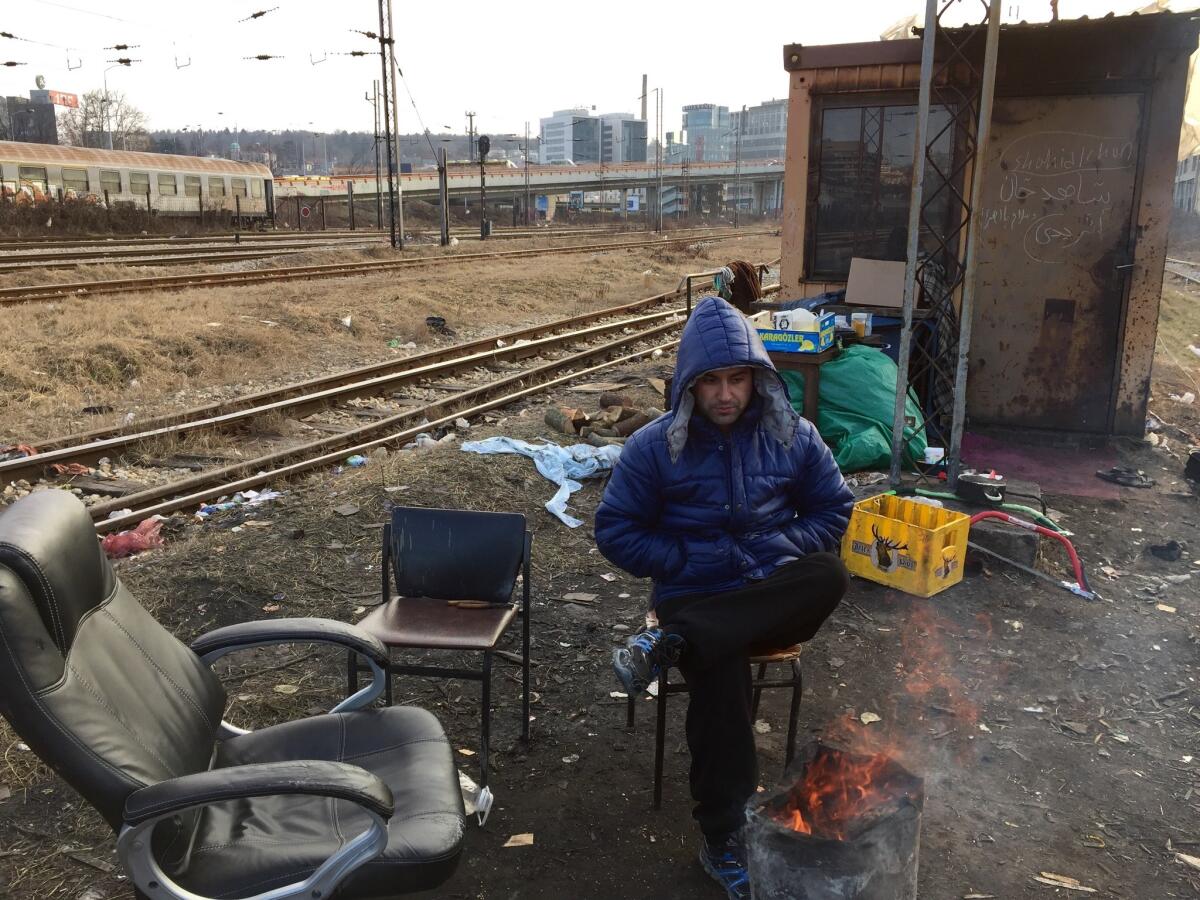
- Share via
Reporting from Belgrade, Serbia — He was, by his account, the go-to shopkeeper for U.S. troops at a small outpost in northern Afghanistan, stocking appliances, construction materials, the latest headphones and an endless supply of Monster energy drinks.
Then the base closed, the Americans departed — and Taliban threats against his life began.
Now Tariq Stanikzay sleeps alongside six other Afghan men in a freezing metal shed behind the main train station in Belgrade, the Serbian capital, with blankets and strips of cardboard pressed against the walls for insulation.
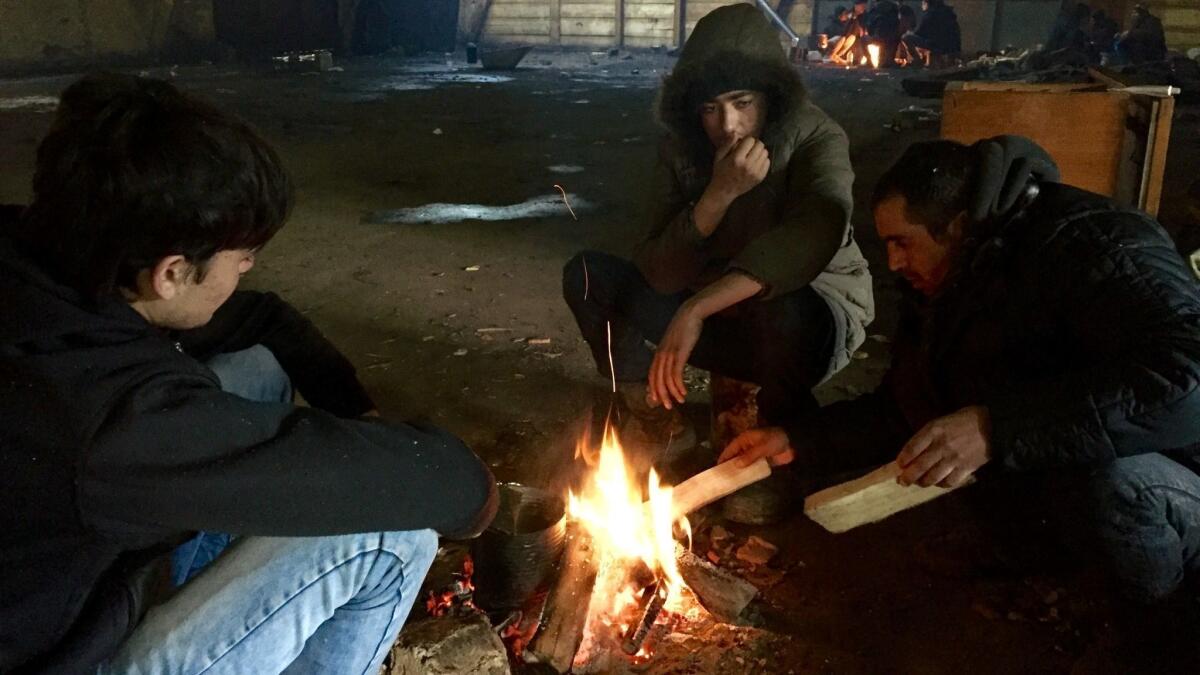
Hundreds of Afghans, Pakistanis, Syrians and others huddle here in abandoned warehouses and sheds that run along the tracks of the 19th century depot, burning donated firewood, old boxes and strips of tires during a winter when nighttime temperatures have touched zero degrees.
This is where their flight from poverty and violence has ended, at least for now: at the doorstep to a Europe that is trying to shut the door on migrants.
Dark smoke from the fires stings their eyes and throats, then puffs through cracked windowpanes into the gray sky. Men step across rivers of trash and wash themselves from public taps, yelping as the cold water hits their shivering skin.
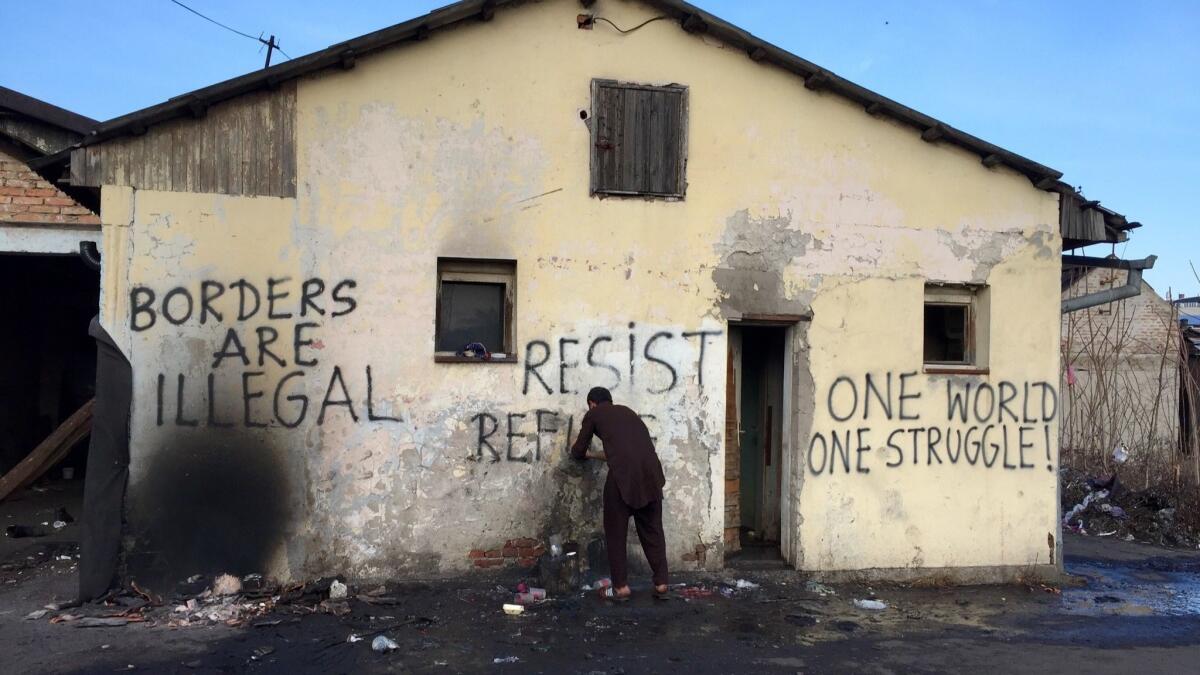
At night they boil pots of tea and huddle around the flames, young faces creased with the worry that their dreams of reaching Europe have grown more elusive than ever.
“I feel that I’m very unlucky,” said the 25-year-old Stanikzay, who left Afghanistan last fall after the U.S. rejected his asylum application, according emails he provided to The Times.
“Before, the way to Europe was easier. I have so many friends who made it to Britain and Germany. But as soon as I started on this journey, everything closed.”
The Balkan nation of Serbia was once a brief stop along the overland route to Western Europe. In 2015, approximately 800,000 refugees and migrants passed through the country, according to government figures. Those numbers have plunged since last March as Europe tried to close the so-called Balkan route and Serbia’s EU neighbors erected razor-wire fences and employed harsh police tactics along their borders.
I’d like someone to explain to me how people can be living in these circumstances on the world’s richest continent.
— Lydia Gall, Eastern Europe researcher, Human Rights Watch
But smugglers continue to use the route, bringing 100,000 migrants through Serbia over the past 12 months, the government estimates. Here they are often stranded for months, making multiple attempts to continue into the next country.
Stanikzay has tried six times to sneak over the border into the European Union countries of Hungary, Croatia or Romania, continuing a journey that he hopes will end with asylum in Britain. Each time, he has been stopped by baton-wielding security forces and guard dogs and sent back, returning to this squalid migrant camp in the shadow of the train station.
Doctors Without Borders has set up medical tents, and local charities distribute basics such as bread and toilet paper. The grim conditions have drawn comparisons to “the Jungle,” the sprawling migrant camp in Calais that French authorities cleared last fall.
“I’d like someone to explain to me how people can be living in these circumstances on the world’s richest continent,” said Lydia Gall, Eastern Europe researcher for Human Rights Watch.
Stanikzay initially slept on the cold concrete inside the warehouses but left after a lice outbreak and because the smoke from burning tires gave him a bad cough. His shed lies between the train tracks and a rock-strewn construction site where a $3.7-billion, Emirati-financed complex of hotels and luxury apartments is rising at the confluence of the Danube and Sava rivers.
The youngest of seven brothers, Stanikzay ran a shop for several years for U.S. troops at Combat Outpost Xio Haq, in Laghman province east of Kabul. On Christmas Day in 2011, he and his brother Zahid, a military interpreter, submitted applications for special immigrant visas, designed to allow Afghans who worked for U.S. forces to resettle in America.
After the U.S. closed the base in 2013, Taliban militants posted two letters on the walls of the mosque in their village, threatening the brothers by name for working with the Americans. Stanikzay tore up the first in anger, but his brother kept the second, hoping it would bolster their chances for asylum, according to ex-soldiers familiar with their case.
Zahid’s application was eventually approved, allowing him and his wife to move to Denver. But in 2015, U.S. officials rejected Stanikzay on the grounds that he had not formally been a military employee, he said.
Stanikzay feared that militants would not see the distinction. In 2016, residents in their village began hearing that fighters loyal to Islamic State had settled in the province. Rumors circulated that the militants had biometric scanning machines that would identify anyone who had worked with foreign troops.
“I panicked,” Stanikzay said over the din of a passing train.
He set off six months ago, crossing into Iran, Turkey and then the EU nation of Bulgaria, the start of the Balkan route. At the border he was beaten by Bulgarian police and detained for several weeks in a walled-off migrant camp. Other refugees say they have been forcibly pushed back across the border by security forces — and, in some cases, local vigilantes — in what human rights groups describe as violations of international laws protecting asylum-seekers.
Those who make it to Serbia, which lies outside the EU, complain of similar treatment at its northern borders — particularly from police in Hungary, whose hard-line prime minister has called immigration “poison.”
Faisan Hazarmir, a 16-year-old Afghan, trudged into the warehouse one evening this month, his feet stuffed into a ratty pair of shoes at least two sizes too small.
The lanky teenager had just been sent back from the border — it was his eighth or ninth attempt at what smugglers call “the game” — by Hungarian police who assaulted him with sticks, broke his phone, rubbed snow in his hair and confiscated his shoes, he said. He rode a bus back to Belgrade wearing a pair of boots he found abandoned by another migrant.
Like most, Hazarmir has no interest in seeking asylum in Serbia. “But the police here treat us 1,000 times better than in Hungary,” he said.
Having taken in nearly 1 million refugees during the Balkan wars of the 1990s, Serbian officials say they are committed to respecting the rights of the current wave of asylum seekers, even as they warn that they cannot take in many more. The country now hosts more than 6,600 migrants in 17 government-run centers with hot meals and heating. At the same time last year, there were just 2,000.
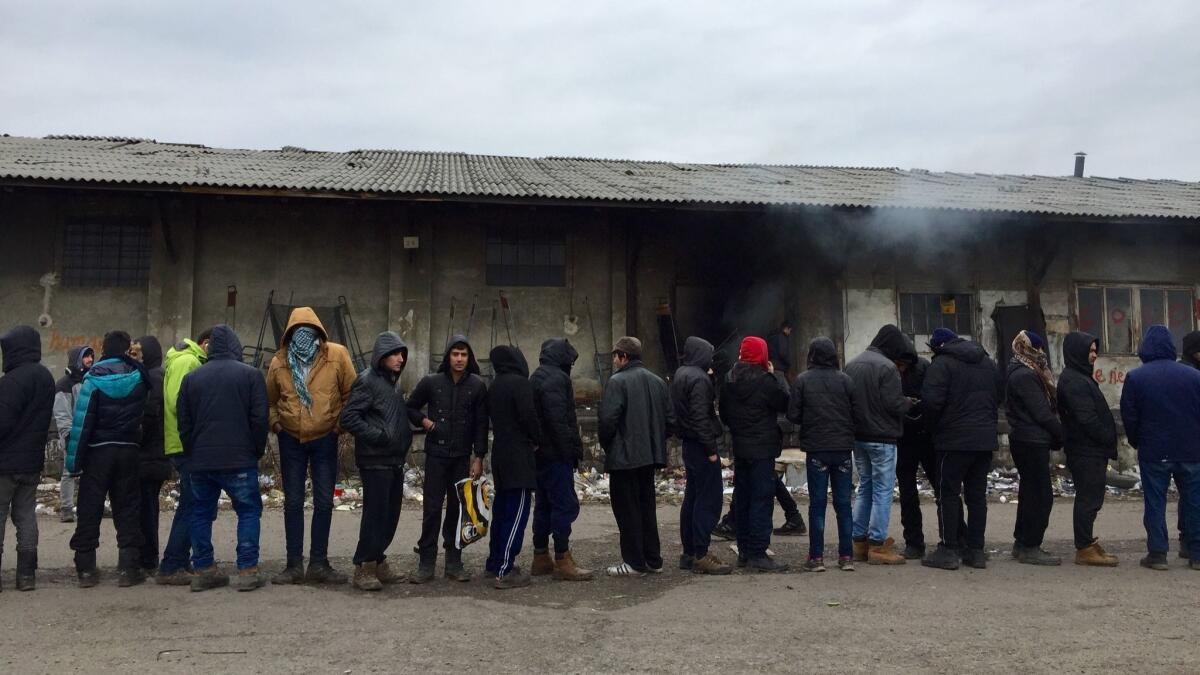
“We are only a transit country, so we can only be a good host on their perilous journey,” said Ivan Miskovic, spokesman for the Serbian government commission on refugees. “What’s very frustrating for the migrants is that they reach right to the gates of Europe, but they can’t continue.”
Humanitarian officials wonder whether Serbia — which is seeking EU membership — will eventually adopt the tougher border policies of its neighbors.
“We’ll see more pressure from upstream countries on Serbia to close the border,” said Mirjana Milenkovski, spokeswoman for the United Nations refugee agency in Belgrade. “You’ll see Serbia try to act as a good soldier, but under pressure to adopt these unlawful tactics.”
During one of the coldest winters in years, with frostbite racing through the migrant camp, the Serbian government last month opened a new shelter at an old military barracks half an hour south of Belgrade. It is now home to roughly 700 men and boys who sleep in bunk beds and take meals in a canteen — but harbor hopes of continuing to Europe once the weather improves.
Ismail Omar, a 52-year-old painter from Homs, Syria, reached Serbia with his son three months ago. On their last attempt to cross into Hungary, muzzled police dogs clawed at his foot, leaving him with a limp.
“I came here to rest, eat and relax, and then we will try again,” said Omar, who said he had paid smugglers $8,000 to get him this far. “We will try again and again until we die.”
Stanikzay and others remain near the train station where they have easier access to smugglers, or because of false rumors that Serbian authorities will deport them from the shelters. Thanks to cheap mobile Internet — and a Good Samaritan who connected their shed to a power line a few weeks ago — Stanikzay spends most of his days on Facebook or texting smugglers about the next “game.”
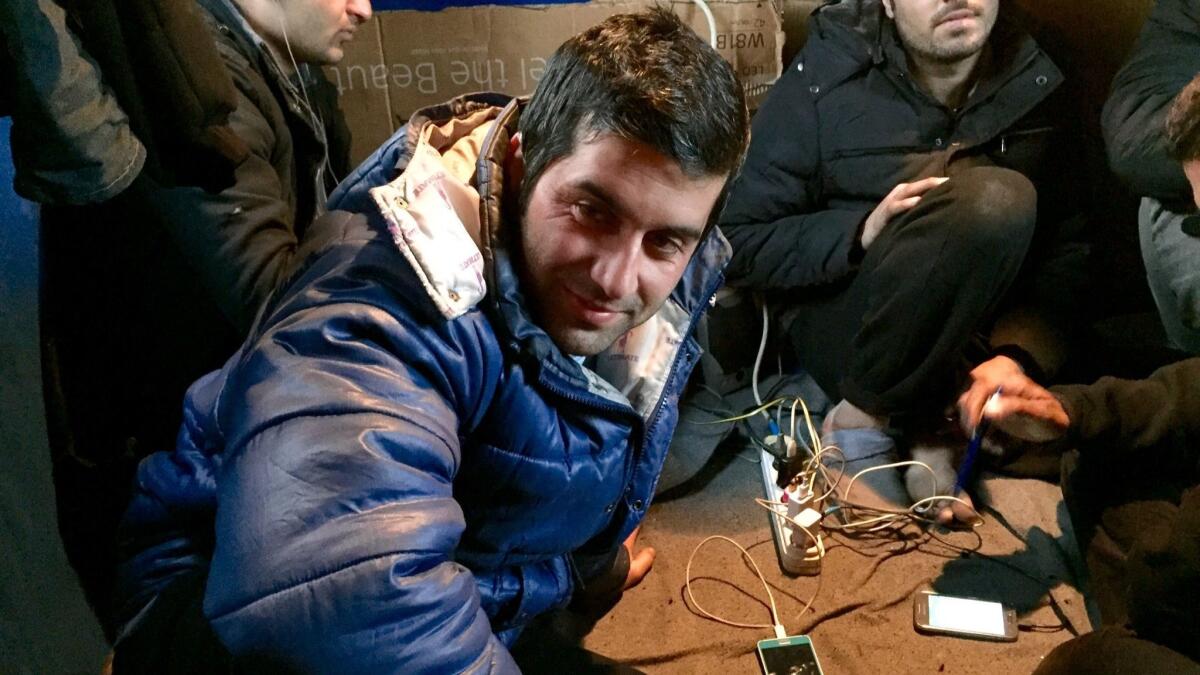
As the borders grow tighter, migrants are adopting riskier tactics. Earlier this month, about 20 Afghans led by Pakistani smugglers tried to cross into Hungary over the frozen Tisza River. The ice cracked under their feet, and one man drowned.
But Stanikzay remained hopeful. Just days before, he said, nine Afghan friends had reached Hungary by hiding in the back of a cargo truck.
“I have to keep trying. I’ll never go back to Afghanistan,” Stanikzay said. He stepped outside and pulled the hood of his jacket tightly over his head.
“Sometime in the future, when I sit in a warm place, I’ll think back on this and remember everything.”
------------
FOR THE RECORD
Jan. 26, 3:14 p.m.: This story incorrectly described threatening letters that Tariq Stanikzay received from the Taliban. The letters were sent starting in 2011, not 2013. One letter was posted at a mosque while another was delivered to Stanikzay’s family’s farm, and neither was destroyed. The errors came to light during legal proceedings in the Netherlands, where Stanikzay is seeking asylum.
------------
Follow @SBengali on Twitter for more news from South Asia
ALSO
This Berlin boulevard bustles with the sights, sounds and scents of the Middle East
Fleeing Syria: A desperate migration
More to Read
Sign up for Essential California
The most important California stories and recommendations in your inbox every morning.
You may occasionally receive promotional content from the Los Angeles Times.














